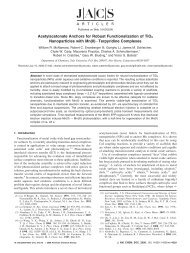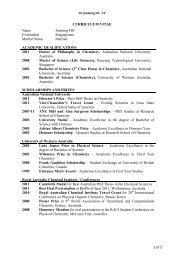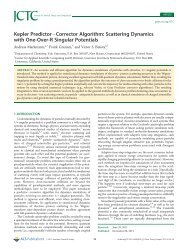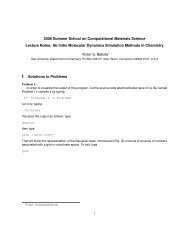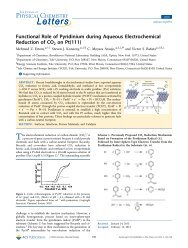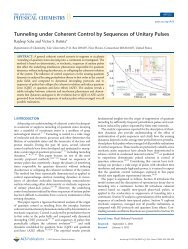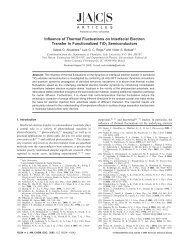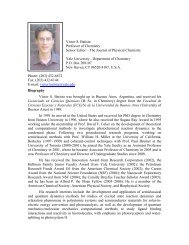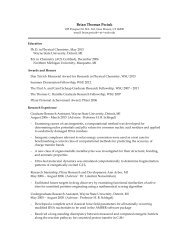Organometallic Ni Pincer Complexes for the Electrocatalytic ...
Organometallic Ni Pincer Complexes for the Electrocatalytic ...
Organometallic Ni Pincer Complexes for the Electrocatalytic ...
You also want an ePaper? Increase the reach of your titles
YUMPU automatically turns print PDFs into web optimized ePapers that Google loves.
Inorganic Chemistry<br />
Article<br />
Figure 1. <strong>Ni</strong>ckel complexes used in <strong>the</strong> study of proton-reduction electrocatalysis. 23,24<br />
Their electrochemistry has now been studied in a standard 0.1<br />
M acetonitrile/supporting electrolyte solution to determine<br />
<strong>the</strong>ir reduction potentials and establish any correlation between<br />
<strong>the</strong>ir catalytic activity and <strong>the</strong> ligand donor power (Figure 2).<br />
negative overpotential at 1.5 mA cm −2 <strong>for</strong> 2 (−0.370 V), than<br />
<strong>for</strong> 1 (−0.345 V).<br />
Table 1. Relative Rates of Proton Reduction in a 0.1 M<br />
NBu 4 BF 4 Acetonitrile Solution and Overpotentials of<br />
Catalysts 1 and 2 at 1.5 mA cm −2<br />
catalyst k (M −2 s −1 )<br />
TOF<br />
(s −1 )<br />
rate overpotential b at faradaic<br />
(M s −1 ) a 1.5 mA cm −2 yield c<br />
1 0.55 × 10 4 ± 54.6 0.275 −0.370 V 90% ±<br />
0.32 × 10 3 3%<br />
2 2.9 × 10 4 ± 209 1.045 −0.345 V 95% ±<br />
1.7 × 10 3 4%<br />
a Calculated <strong>for</strong> 0.1 M H + , 5 mM catalyst, using <strong>the</strong> method described<br />
by DuBois et al. 26 b Value determined from plots of current density vs<br />
applied potential constructed from chronoamperograms (dwell time:<br />
60 s) at progressively more negative potentials corrected <strong>for</strong> [H + ]=<br />
0.037 M (<strong>the</strong> pH = −log[H + ] = 1.42, E o ′ = −59 mV/pH*1.42 = −84<br />
mV vs NHE). The working electrode was a 3 mm diameter glassy<br />
carbon disk. Measurements were per<strong>for</strong>med with magnetic stirring,<br />
using 5.2 mL acetonitrile solutions containing 200 μL of 1 M aqueous<br />
HCl at catalyst concentrations of 0.2 mM with Ar purge. c From bulk<br />
electrolyses at −0.6 V vs NHE, (details in <strong>the</strong> Experimental Section<br />
and Supporting In<strong>for</strong>mation).<br />
Figure 2. Solid lines: Nonaqueous electrochemistry of compounds 1<br />
and 2: 2 mM <strong>Ni</strong> complex in a 0.1 M NBu 4 BF 4 acetonitrile solution at a<br />
glassy carbon electrode (100 mV/s) top to bottom: blue 1; purple 2. See<br />
Supporting In<strong>for</strong>mation <strong>for</strong> CVs of complexes 1 and 2 at different scan<br />
rates. Dashed lines: 2 mM solutions of complexes 1 and 2 in a 0.1 M<br />
NBu 4 BF 4 acetonitrile solution with 20 μL 1 M HCl at 100 mV/s.<br />
Our results confirm <strong>the</strong> expectation that a more strongly donor<br />
ligand framework stabilizes <strong>the</strong> higher oxidation state and<br />
makes metal reduction more difficult (See Figure 2 and<br />
Supporting In<strong>for</strong>mation <strong>for</strong> details).<br />
<strong>Complexes</strong> 1 and 2 show similar electrochemical behavior.<br />
They both show a single reduction wave which we assign to a<br />
<strong>Ni</strong> II /<strong>Ni</strong> I couple. Complex 1 is more easily reduced than<br />
complex 2 which is consistent with <strong>the</strong> more donating<br />
framework of <strong>the</strong> PCP ligand in complex 2. 25<br />
Incremental addition of aliquots of a 1 M HCl solution to<br />
complexes 1 and 2 led to a progressive increase in <strong>the</strong> current<br />
observed by voltammetry in this nickel pincer series (see<br />
Supporting In<strong>for</strong>mation). Figure 2 shows comparative cyclic<br />
voltammograms (CVs) of <strong>the</strong> pincer complexes in <strong>the</strong> presence<br />
of 20 μL of 1 M HCl. Compound 1 showed an irreversible<br />
wave with a less negative onset potential than <strong>the</strong> one observed<br />
<strong>for</strong> 2 under <strong>the</strong> same conditions. As expected, increasingly<br />
donor ligands appear to provide more negative onset potentials.<br />
Both waves are consistent with catalytic H 2 production,<br />
although <strong>the</strong> onset of catalysis is at much higher potentials<br />
than <strong>the</strong> reduction potentials of 1 and 2 in <strong>the</strong> absence of acid,<br />
an explanation <strong>for</strong> which is presented later. Plots of current<br />
density vs applied potential were constructed <strong>for</strong> catalysts 1 and<br />
2 (Table 1 and Supporting In<strong>for</strong>mation, S2) and show a more<br />
The rates of H 2 production were measured from<br />
voltammetry in acetonitrile (Table 1) using <strong>the</strong> method of<br />
DuBois and co-workers 14 described in detail in <strong>the</strong> Supporting<br />
In<strong>for</strong>mation. Our data are consistent with an overall third order<br />
rate law: <strong>the</strong> reaction is second order in acid and first order in<br />
catalyst. Catalyst 2 has a TOF of 209 s −1 under <strong>the</strong> reaction<br />
conditions, which is faster than catalyst 1 (54.6 s −1 ). The<br />
Faradaic yield of H 2 production by 1 and 2, measured using<br />
bulk electrolysis followed by quantitative mass spectrometry<br />
detection of H 2 , is excellent, with approximately 90% yield<br />
observed in both cases. We believe that our catalysts are<br />
operationally homogeneous as UV−vis spectra of <strong>the</strong> catholyte<br />
be<strong>for</strong>e and after electrolyses show that <strong>the</strong> characteristic<br />
spectroscopic features of <strong>the</strong> catalysts are maintained,<br />
suggesting that significant decomposition is not occurring.<br />
Fur<strong>the</strong>rmore, when <strong>the</strong> electrode was removed after<br />
electrolyses, rinsed, and immersed in fresh electrolyte, no<br />
catalytic response was observed. This suggests an insoluble<br />
heterogeneous nickel catalyst is not being deposited on <strong>the</strong><br />
electrode. The difference in catalytic rates based on <strong>the</strong> ligand is<br />
also consistent with a homogeneous system. Overall, our<br />
complexes appear to be slower catalysts in acetonitrile than<br />
DuBois’ <strong>Ni</strong> tetraphosphine systems, 14,17,18 but <strong>the</strong>y operate at<br />
similar overpotentials. However, direct comparison is complicated<br />
because of differences in <strong>the</strong> exact experimental<br />
conditions.<br />
Proposed Catalytic Cycle and Mechanistic Experiments.<br />
Although <strong>the</strong> mechanism <strong>for</strong> proton reduction using<br />
tetraphosphine systems such as those described by DuBois is<br />
relatively well understood, 17 we were interested in comparing it<br />
to our PCP supported systems. As in previous studies, we<br />
8705<br />
dx.doi.org/10.1021/ic300009a | Inorg. Chem. 2012, 51, 8704−8709



